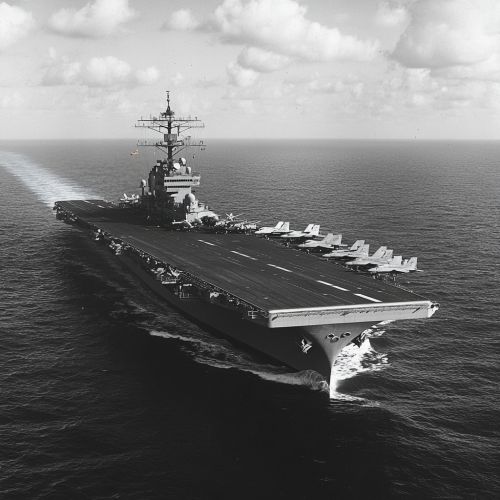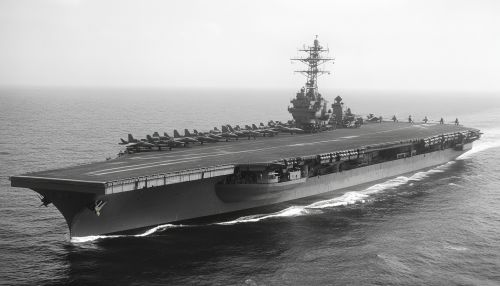Lexington-class aircraft carrier
Introduction
The Lexington-class aircraft carrier was a class of two aircraft carriers built for the United States Navy during the 1920s. Originally designed as battlecruisers, they were converted to aircraft carriers to comply with the Washington Naval Treaty of 1922. The class comprised two ships: USS Lexington (CV-2) and USS Saratoga (CV-3). These carriers played significant roles during the early years of World War II and were among the largest and most powerful aircraft carriers of their time.
Design and Development
Background
The Lexington-class carriers were initially conceived as part of the U.S. Navy's plan to build six battlecruisers. However, the Washington Naval Treaty imposed limitations on naval armaments, leading to the conversion of these ships into aircraft carriers. The treaty allowed the conversion of two battlecruisers into carriers, resulting in the creation of the Lexington-class.
Specifications
The Lexington-class carriers had a standard displacement of 33,000 tons and a full-load displacement of approximately 43,000 tons. They measured 888 feet (271 meters) in length overall, with a beam of 106 feet (32 meters) and a draft of 30 feet (9.1 meters). The flight deck was 866 feet (264 meters) long and 106 feet (32 meters) wide.
The propulsion system consisted of four geared steam turbines, each driving one propeller shaft, with steam provided by 16 Yarrow boilers. This configuration produced a total of 180,000 shaft horsepower, enabling the carriers to achieve a maximum speed of 33.25 knots (61.58 km/h).
Armament and Armor
Armament
The primary armament of the Lexington-class carriers consisted of eight 8-inch (203 mm) guns mounted in four twin turrets, two forward and two aft. These guns were intended for use against surface targets. Additionally, the carriers were equipped with twelve 5-inch (127 mm) anti-aircraft guns in single mounts for defense against aerial threats.
Armor
The armor protection of the Lexington-class carriers was relatively light compared to contemporary battleships. The flight deck was armored with 1.5 inches (38 mm) of steel, while the hangar deck had 2 inches (51 mm) of armor. The belt armor ranged from 5 to 7 inches (127 to 178 mm) in thickness, and the conning tower was protected by 6.5 inches (165 mm) of armor.
Aircraft and Aviation Facilities
Aircraft Capacity
The Lexington-class carriers were designed to carry a complement of 78 aircraft, including fighters, bombers, and torpedo planes. The exact composition of the air group varied over time, but typically included Grumman F4F Wildcat fighters, Douglas SBD Dauntless dive bombers, and Douglas TBD Devastator torpedo bombers.
Aviation Facilities
The carriers featured a full-length flight deck with two hydraulic catapults for launching aircraft. The hangar deck, located below the flight deck, provided storage and maintenance facilities for the aircraft. Two large elevators, each capable of lifting 10,000 pounds (4,500 kg), connected the hangar and flight decks, facilitating the movement of aircraft.


Operational History
USS Lexington (CV-2)
USS Lexington (CV-2) was commissioned on December 14, 1927. During the interwar period, she participated in numerous fleet exercises and training operations, demonstrating the potential of naval aviation. At the outbreak of World War II, Lexington was stationed in the Pacific.
In May 1942, Lexington played a crucial role in the Battle of the Coral Sea, the first naval battle in history where opposing ships never sighted each other and fought entirely with aircraft. Despite her significant contributions, Lexington was heavily damaged by Japanese aircraft and subsequently scuttled to prevent capture.
USS Saratoga (CV-3)
USS Saratoga (CV-3) was commissioned on November 16, 1927. Like her sister ship, Saratoga was active in fleet exercises and training operations during the interwar years. At the start of World War II, she was also stationed in the Pacific.
Saratoga participated in several key battles, including the Battle of Guadalcanal and the Battle of the Eastern Solomons. She was torpedoed by a Japanese submarine in January 1942 but was repaired and returned to service. Saratoga continued to serve throughout the war, providing air support during the invasions of Iwo Jima and Okinawa. After the war, she was used as a target ship during the Operation Crossroads nuclear tests at Bikini Atoll in 1946.
Legacy
The Lexington-class carriers were instrumental in demonstrating the effectiveness of aircraft carriers in naval warfare. Their design influenced subsequent carrier development, and their operational experiences provided valuable lessons for future carrier operations. The class's contributions to World War II underscored the importance of naval aviation and helped establish the aircraft carrier as a dominant force in modern naval warfare.
See Also
- Washington Naval Treaty
- Grumman F4F Wildcat
- Douglas SBD Dauntless
- Douglas TBD Devastator
- Battle of the Coral Sea
- Battle of Guadalcanal
- Battle of the Eastern Solomons
- Operation Crossroads
References
- [Insert references here]
